An Improved Case-Based Reasoning Model for Simulating Urban Growth
Abstract
1. Introduction
2. Materials and Methods
2.1. Study Area
2.2. Data Sources and Processing
2.3. The Model
2.3.1. Case Expression and Collection
- (1)
- Case Expression Structure
- (2)
- Case Expression Mode
- ①
- “Initial state” describes the land use type at the beginning of the case. Each case has only one state at a certain time;
- ②
- “Geographic features” include a set of spatial data indices that affect urban growth. The indicators are the key features that influence the urbanization process (the transformation to urban land) of a case by describing the geographical environment at the beginning of the case change;
- ③
- “Result” describes the urbanization outcome of the case at the end of the change. It indicates whether or not the case transformed into urban land.
- (3)
- Case Collection
2.3.2. Case Retrieval
- (1)
- Basic Case Retrieval Strategy
- (2)
- Comprehensive Case Retrieval Strategy
2.3.3. Case Constraint
2.4. Parameters Preparation and Implementation of Model
2.4.1. The Implementation of Case Expression
2.4.2. The Implementation of Case Retrieval
2.4.3. The Implementation of Case Constraint
3. Results and Discussion
3.1. Evaluation of Authenticity of Simulation Result
3.2. Evaluation of Effectiveness of Comprehensive Retrieval Strategy
3.3. Contrast with the CA Model
- (1)
- CA simulation is a process based on neighborhood evolution, meaning that new urban growth land is inevitably adjacent to existing urban land. Thus, the simulation result is often affected by the cluster effect, which makes it difficult to simulate the enclave growth process and leads to a certain deviation from the actual urban pattern. Urban growth CBR simulation only considers the background conditions of each case and is not restricted by neighborhood conditions. Therefore, it can better reflect the spatial distribution trends of urban growth.
- (2)
- The effectiveness of CA greatly depends on the mining of transformation rules; if the rules are expressed in a too simple or too complex way, then this is not conducive to model simulation. Urban growth CBR is a kind of black-box reasoning process; it can effectively avoid the problems caused by rule mining, and its process for creating the case base is easier than CA’s process for constructing rules. From this point of view, the urban growth CBR model is simpler and easier to understand than CA.
- (3)
- Urban growth CBR is an empirical reasoning method, meaning that its simulation accuracy will be restricted by experience. If the number of geographical cases is too small, then it will be difficult to guarantee the model’s accuracy. At the same time, the number of cases also affects the model’s operation speed. Collecting a large number of geographical cases to improve the accuracy will decrease the model’s operation efficiency. However, CA requires less computation than urban growth CBR, and so simulation results can be obtained more quickly.
4. Conclusions
Author Contributions
Funding
Institutional Review Board Statement
Informed Consent Statement
Data Availability Statement
Acknowledgments
Conflicts of Interest
References
- Angel, S.; Parent, J.; Civco, D.L.; Blei, A.; Potere, D. The dimensions of global urban expansion: Estimates and projections for all countries, 2000–2050. Prog. Plann. 2011, 75, 53–107. [Google Scholar] [CrossRef]
- Xia, H.; Qin, Y.; Feng, G.; Meng, Q.; Cui, Y.; Song, H.; Ouyang, Y.; Liu, G. Forest Phenology Dynamics to Climate Change and Topography in a Geographic and Climate Transition Zone: The Qinling Mountains in Central China. Forests 2019, 10, 1007. [Google Scholar] [CrossRef]
- Zhou, H.; Xu, M.; Hou, R.; Zheng, Y.; Chi, Y.; Ouyang, Z. Thermal acclimation of photosynthesis to experimental warming is season-dependent for winter wheat (Triticum aestivum L.). Environ. Exp. Bot. 2018, 150, 249–259. [Google Scholar] [CrossRef]
- Yu, S.; Zhang, Z.; Liu, F.; Wang, X.; Hu, S. Urban expansion in the megacity since 1970s: A case study in Mumbai. Geocarto. Int. 2019, 1–19. [Google Scholar] [CrossRef]
- Seto, K.C.; Guneralp, B.; Hutyra, L.R. Global forecasts of urban expansion to 2030 and direct impacts on biodiversity and carbon pools. Proc. Natl. Acad. Sci. USA 2012, 109, 16083–16088. [Google Scholar] [CrossRef]
- Zhang, T. Land market forces and government’s role in sprawl: The case of China. Cities 2000, 17, 123–135. [Google Scholar] [CrossRef]
- Han, L.; Zhou, W.; Li, W. Increasing impact of urban fine particles (PM2.5) on areas surrounding Chinese cities. Sci. Rep. 2015, 5, 12467. [Google Scholar] [CrossRef]
- You, H.; Yang, X. Urban expansion in 30 megacities of China: Categorizing the driving force profiles to inform the urbanization policy. Land Use Policy 2017, 68, 531–551. [Google Scholar] [CrossRef]
- Meng, L.; Sun, Y.; Zhao, S. Comparing the spatial and temporal dynamics of urban expansion in Guangzhou and Shenzhen from 1975 to 2015: A case study of pioneer cities in China’s rapid urbanization. Land Use Policy 2020, 97, 104753. [Google Scholar] [CrossRef]
- Wu, R.; Li, Z.; Wang, S. The varying driving forces of urban land expansion in China: Insights from a spatial-temporal analysis. Sci. Total Environ. 2020, 142591. [Google Scholar] [CrossRef]
- Li, X.; Fan, W.; Wang, L.; Luo, M.; Yao, R.; Wang, S.; Wang, L. Effect of urban expansion on atmospheric humidity in Beijing-Tianjin-Hebei urban agglomeration. Sci. Total Environ. 2021, 759, 144305. [Google Scholar] [CrossRef]
- Liu, J.; Jiao, L.; Zhang, B.; Xu, G.; Yang, L.; Dong, T.; Xu, Z.; Zhong, J.; Zhou, Z. New indices to capture the evolution characteristics of urban expansion structure and form. Ecol. Indic. 2021, 112, 107302. [Google Scholar] [CrossRef]
- Jafari, M.; Majedi, H.; Monavari, S.M.; Alesheikh, A.A.; Zarkesh, M.K. Dynamic simulation of urban expansion through a CA-Markov model Case study: Hyrcanian region, Gilan, Iran. Eur. J. Remote Sens. 2016, 49, 513–529. [Google Scholar] [CrossRef]
- Yao, Y.; Ma, L.; Che, X.; Dou, H. Simulation study of urban expansion under ecological constraint—Taking Yuzhong County, China as an example. Urban. For. Urban. Green 2021, 57, 126933. [Google Scholar] [CrossRef]
- Cheng, J.; Masser, I. Understanding Spatial and Temporal Processes of Urban Growth: Cellular Automata Modelling. Environ. Plann. B Plann. Des. 2004, 31, 167–194. [Google Scholar] [CrossRef]
- Firozjaei, M.K.; Sedighi, A.; Argany, M.; Jelokhani-Niaraki, M.; Arsanjani, J.J. A geographical direction-based approach for capturing the local variation of urban expansion in the application of CA-Markov model. Cities 2019, 93, 120–135. [Google Scholar] [CrossRef]
- Liang, X.; Liu, X.; Li, X.; Chen, Y.; Tian, H.; Yao, Y. Delineating multi-scenario urban growth boundaries with a CA-based FLUS model and morphological method. Landsc. Urban. Plan. 2018, 177, 47–63. [Google Scholar] [CrossRef]
- Tian, G.; Ouyang, Y.; Quan, Q.; Wu, J. Simulating spatiotemporal dynamics of urbanization with multi-agent systems—A case study of the Phoenix metropolitan region, USA. Ecol. Modell 2010, 222, 1129–1138. [Google Scholar] [CrossRef]
- Zhang, H.; Jin, X.; Wang, L.; Zhou, Y.; Shu, B. Multi-agent based modeling of spatiotemporal dynamical urban growth in developing countries: Simulating future scenarios of Lianyungang city, China. Stoch Environ. Res. Risk Assess. 2015, 29, 63–78. [Google Scholar] [CrossRef]
- He, X.; Mai, X.; Shen, G. Delineation of Urban Growth Boundaries with SD and CLUE-s Models under Multi-Scenarios in Chengdu Metropolitan Area. Sustainability 2019, 11, 5919. [Google Scholar] [CrossRef]
- Luo, G.; Yin, C.; Chen, X.; Xu, W.; Lu, L. Combining system dynamic model and CLUE-S model to improve land use scenario analyses at regional scale: A case study of Sangong watershed in Xinjiang, China. Ecol. Complex. 2010, 7, 198–207. [Google Scholar] [CrossRef]
- Liu, Z.; Yang, Y.; He, C.; Tu, M. Climate change will constrain the rapid urban expansion in drylands: A scenario analysis with the zoned Land Use Scenario Dynamics-urban model. Sci. Total Environ. 2019, 651, 2772–2786. [Google Scholar] [CrossRef]
- Du, Y.; Wen, W.; Cao, F.; Ji, M. A case-based reasoning approach for land use change prediction. Expert Syst. Appl. 2010, 37, 5745–5750. [Google Scholar] [CrossRef]
- De Mantaras, R.L.; McSherry, D.; Bridge, D.; Leake, D.; Smyth, B.; Craw, S.; Faltings, B.O.I.; Maher, M.L.; Cox, M.T.; Forbus, K.; et al. Retrieval, reuse, revision and retention in case-based reasoning. Knowl. Eng. Rev. 2005, 20, 215–240. [Google Scholar] [CrossRef]
- Du, Y.; Ge, Y.; Lakhan, V.C.; Sun, Y.; Cao, F. Comparison between CBR and CA methods for estimating land use change in Dongguan, China. J. Geogr. Sci. 2012, 22, 716–736. [Google Scholar] [CrossRef]
- Karen, K. Case-Based Reasoning: An Introduction. Expert Syst. Appl. 1993, 6, 3–8. [Google Scholar] [CrossRef]
- Liao, Z.; Zhou, C.; Tian, W.; Hu, T.; Guo, R. CBR-based integration of a hydrodynamic and water quality model and GIS-a case study of Chaohu City. Environ. Sci. Pollut. Res. 2019, 26, 6436–6449. [Google Scholar] [CrossRef] [PubMed]
- Huang, K.; Nie, W.; Luo, N. Scenario-Based Marine Oil Spill Emergency Response Using Hybrid Deep Reinforcement Learning and Case-Based Reasoning. Appl. Sci. 2020, 10, 5269. [Google Scholar] [CrossRef]
- Somi, S.; Gerami, S.N.; Fayek, A.R. Framework for Risk Identification of Renewable Energy Projects Using Fuzzy Case-Based Reasoning. Sustainability 2020, 12, 5231. [Google Scholar] [CrossRef]
- Liu, W.; Wang, S.; Zhou, Y.; Wang, L.; Zhu, J.; Wang, F. Lightning-caused forest fire risk rating assessment based on case-based reasoning: A case study in DaXingAn Mountains of China. Nat. Hazards 2015, 81, 347–363. [Google Scholar] [CrossRef]
- Machado, D.; de Menezes, M.D.; Silva, S.; Curi, N. Transferability, accuracy, and uncertainty assessment of different knowledge-based approaches for soil types mapping. Catena 2019, 182, 104134. [Google Scholar] [CrossRef]
- Dou, J.; Chang, K.-T.; Chen, S.; Yunus, A.; Liu, J.-K.; Xia, H.; Zhu, Z. Automatic Case-Based Reasoning Approach for Landslide Detection: Integration of Object-Oriented Image Analysis and a Genetic Algorithm. Remote Sens. 2015, 7, 4318–4342. [Google Scholar] [CrossRef]
- Du, Y.; Wu, D.; Liang, F.; Li, C. Integration of case-based reasoning and object-based image classification to classify SPOT images: A case study of aquaculture land use mapping in coastal areas of Guangdong province, China. GIsci. Remote Sens. 2013, 50, 574–589. [Google Scholar] [CrossRef]
- Liu, X.; Ma, L.; Li, X.; Ai, B.; Li, S.; He, Z. Simulating urban growth by integrating landscape expansion index (LEI) and cellular automata. Int. J. Geogr. Inf. Sci. 2014, 28, 148–163. [Google Scholar] [CrossRef]
- Liang, X.; Liu, X.; Li, D.; Zhao, H.; Chen, G. Urban growth simulation by incorporating planning policies into a CA-based future land-use simulation model. Int. J. Geogr. Inf. Sci. 2018, 32, 2294–2316. [Google Scholar] [CrossRef]
- Holt, A. Applying case-based reasoning techniques in GIS. Int. J. Geogr. Inf. Sci. 1999, 13, 9–25. [Google Scholar] [CrossRef]
- McSherry, D. The inseparability problem in interactive case-based reasoning. Knowl. Based Syst. 2002, 15, 293–300. [Google Scholar] [CrossRef]
- Dong, Q.; Ai, X.; Cao, G.; Zhang, Y.; Wang, X. Study on risk assessment of water security of drought periods based on entropy weight methods. Kybernetes 2010, 39, 864–870. [Google Scholar] [CrossRef]
- Pontius, R.G.; Huffaker, D.; Denman, K. Useful techniques of validation for spatially explicit land-change models. Ecol. Model. 2004, 179, 445–461. [Google Scholar] [CrossRef]
- Tong, X.; Feng, Y. A review of assessment methods for cellular automata models of land-use change and urban growth. Int. J. Geogr. Inf. Sci. 2020, 34, 866–898. [Google Scholar] [CrossRef]
- Wolfram, S. Cellular automata: A model of complexity. Nature 1984, 31. [Google Scholar] [CrossRef]
- Li, X.; Liu, X. An extended cellular automaton using case--based reasoning for simulating urban development in a large complex region. Int. J. Geogr. Inf. Sci. 2006, 20, 1109–1136. [Google Scholar] [CrossRef]
- Liu, X.; Liang, X.; Li, X.; Xu, X.; Ou, J.; Chen, Y.; Li, S.; Wang, S.; Pei, F. A future land use simulation model (FLUS) for simulating multiple land use scenarios by coupling human and natural effects. Landsc. Urban. Plan. 2017, 168, 94–116. [Google Scholar] [CrossRef]
- Li, X.; Shi, X.; He, J.; Liu, X. Coupling Simulation and Optimization to Solve Planning Problems in a Fast-Developing Area. Ann. Assoc. Am. Geogr. 2011, 101, 1032–1048. [Google Scholar] [CrossRef]
- Wu, F. Calibration of stochastic cellular automata: The application to rural-urban land conversions. Int. J. Geogr. Inf. Sci. 2002, 16, 795–818. [Google Scholar] [CrossRef]

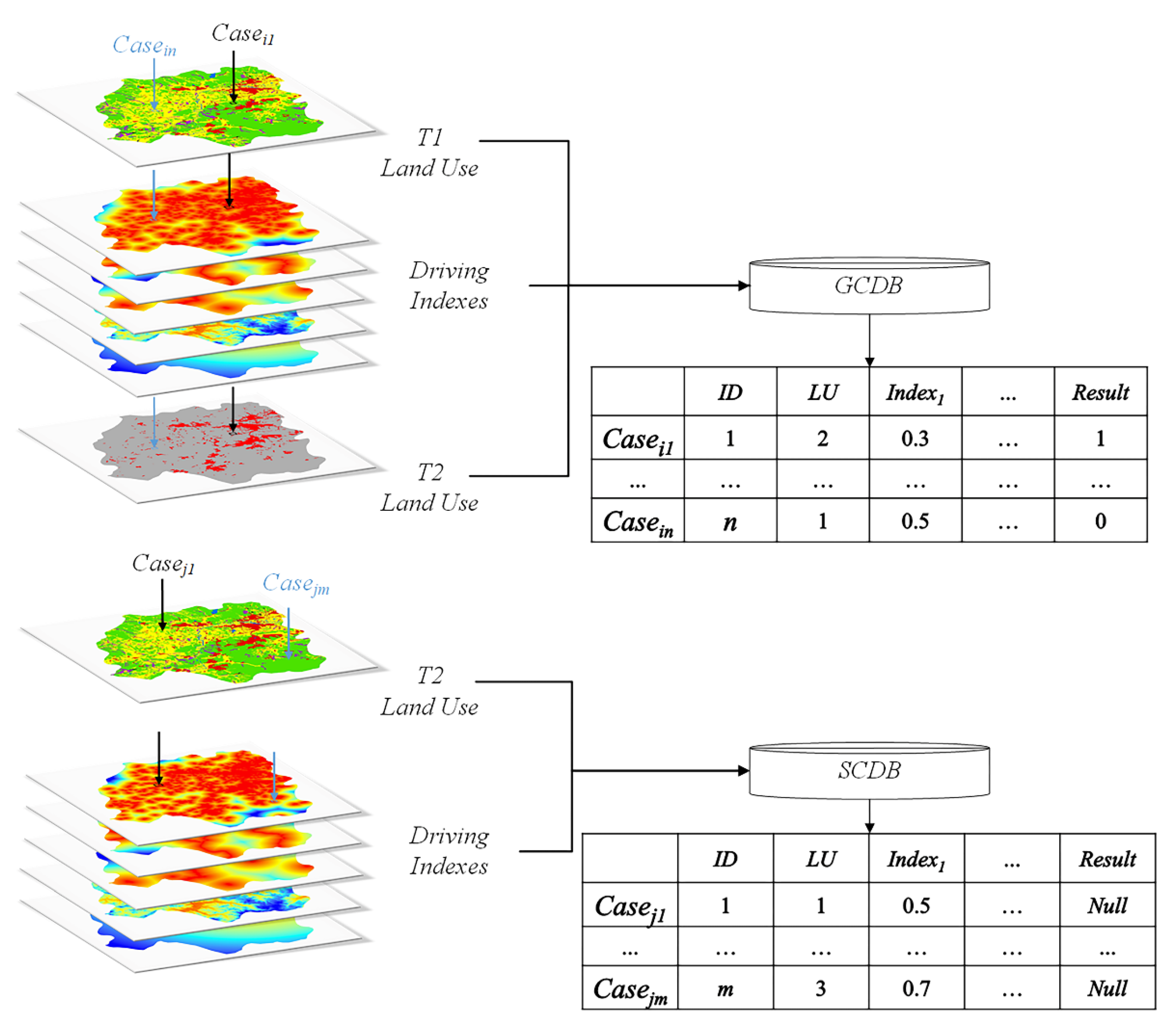

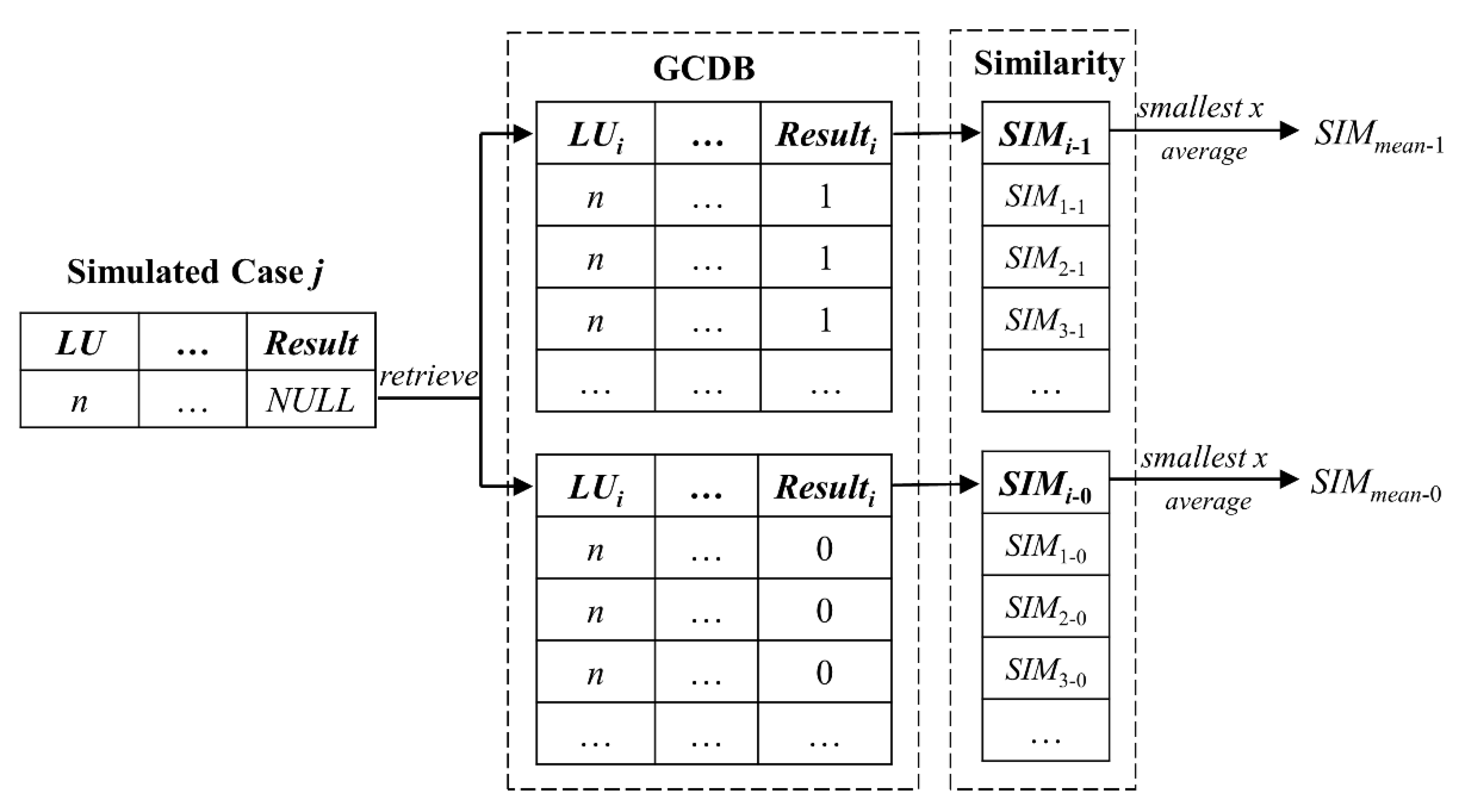

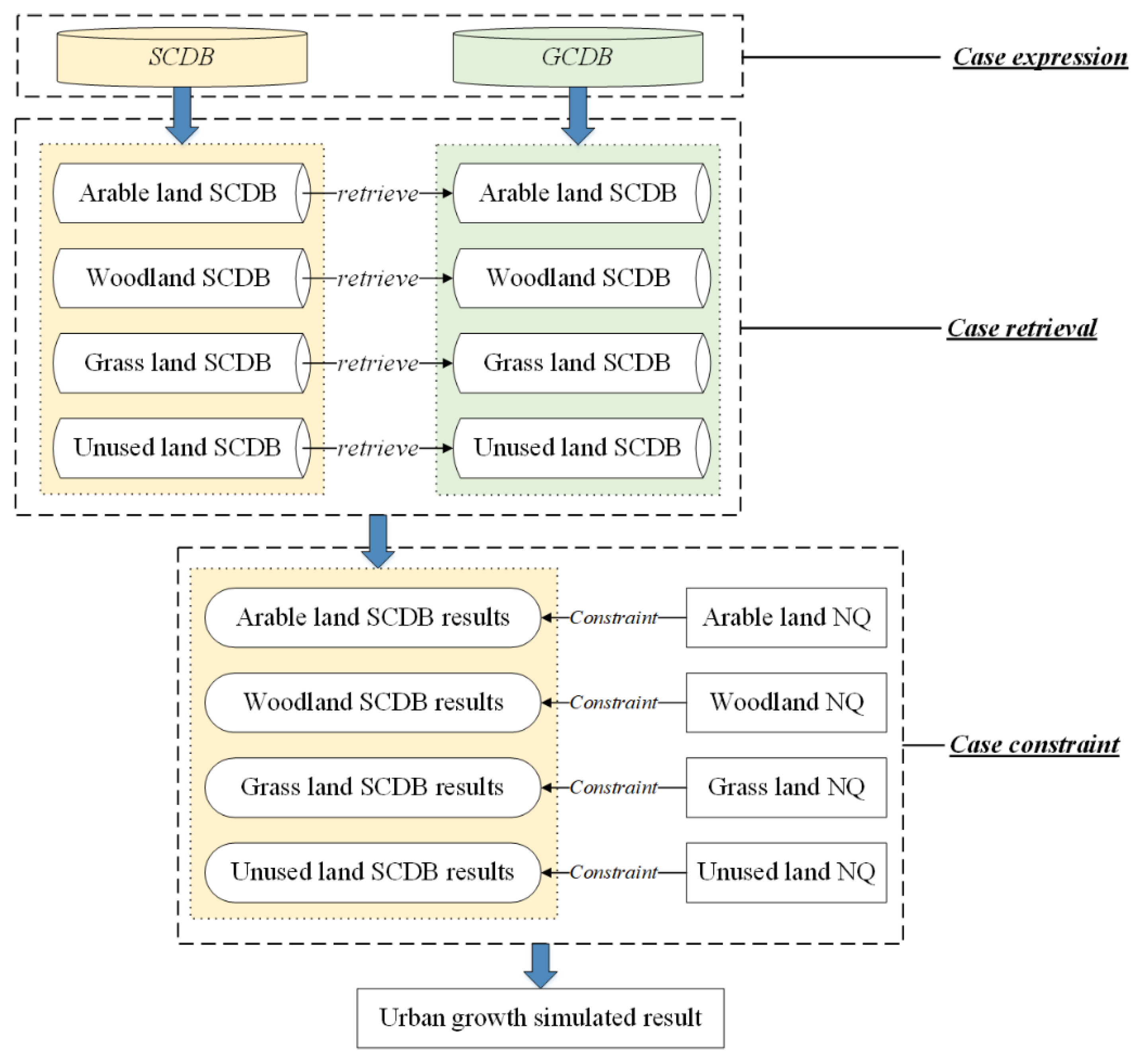
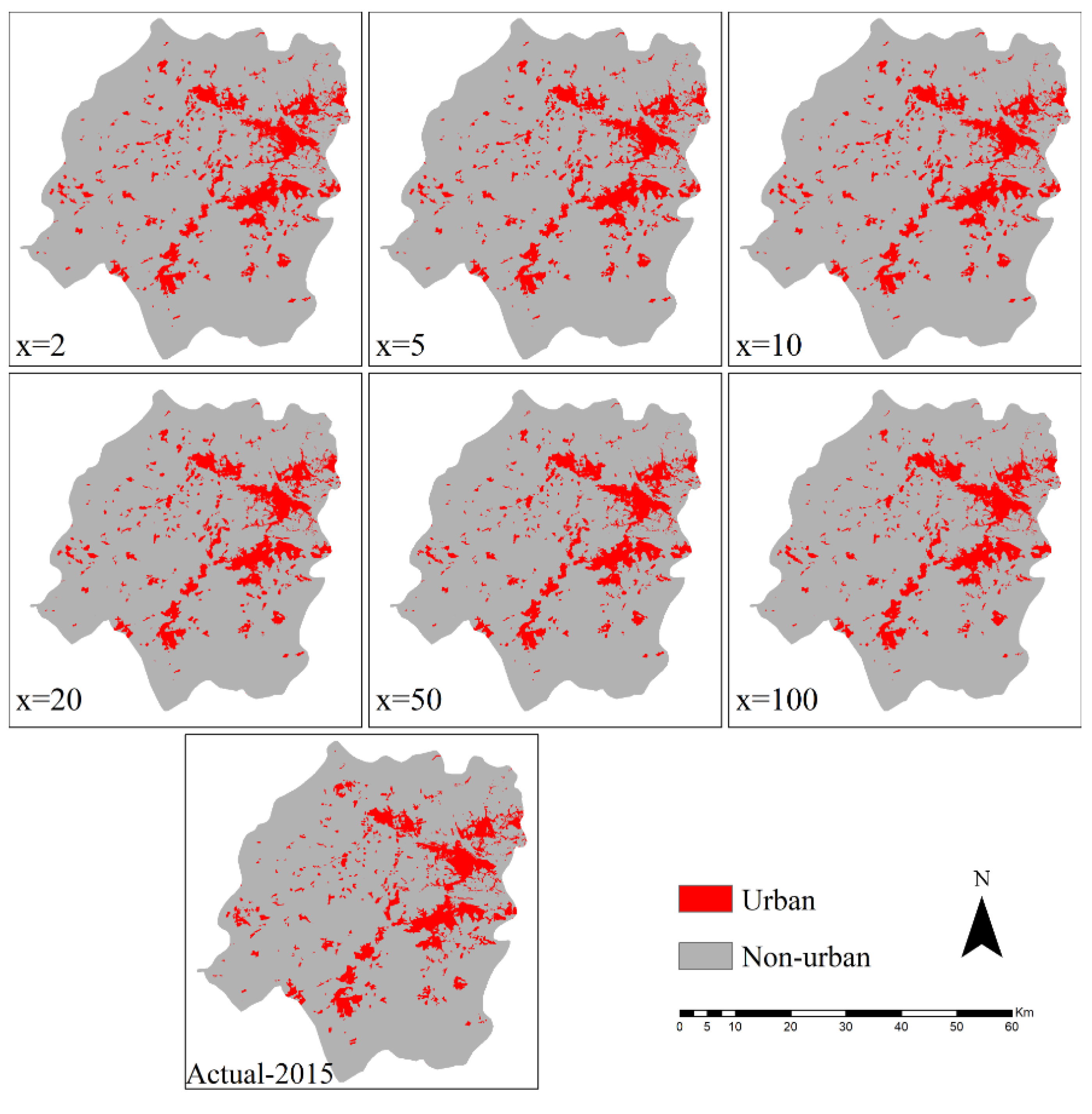
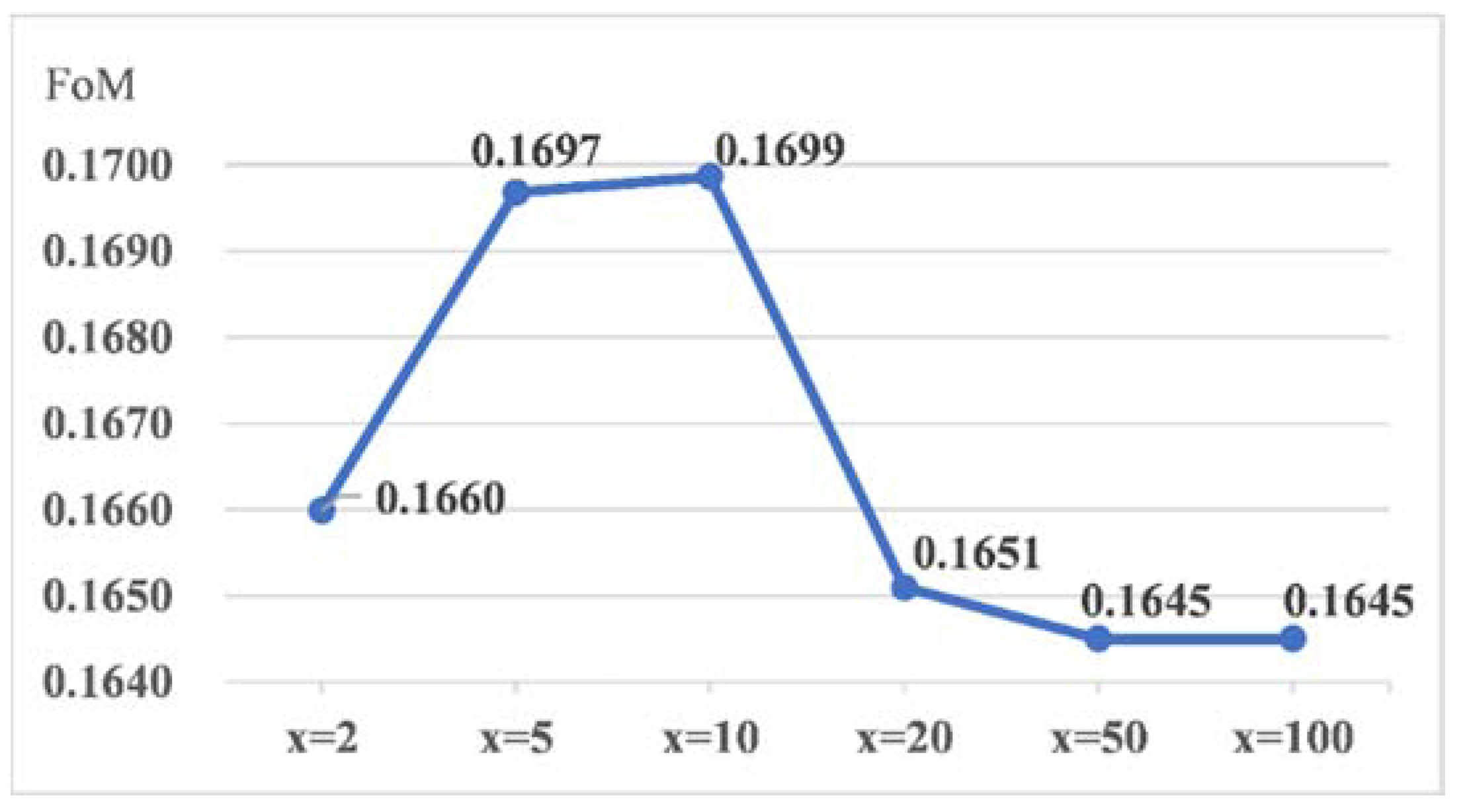
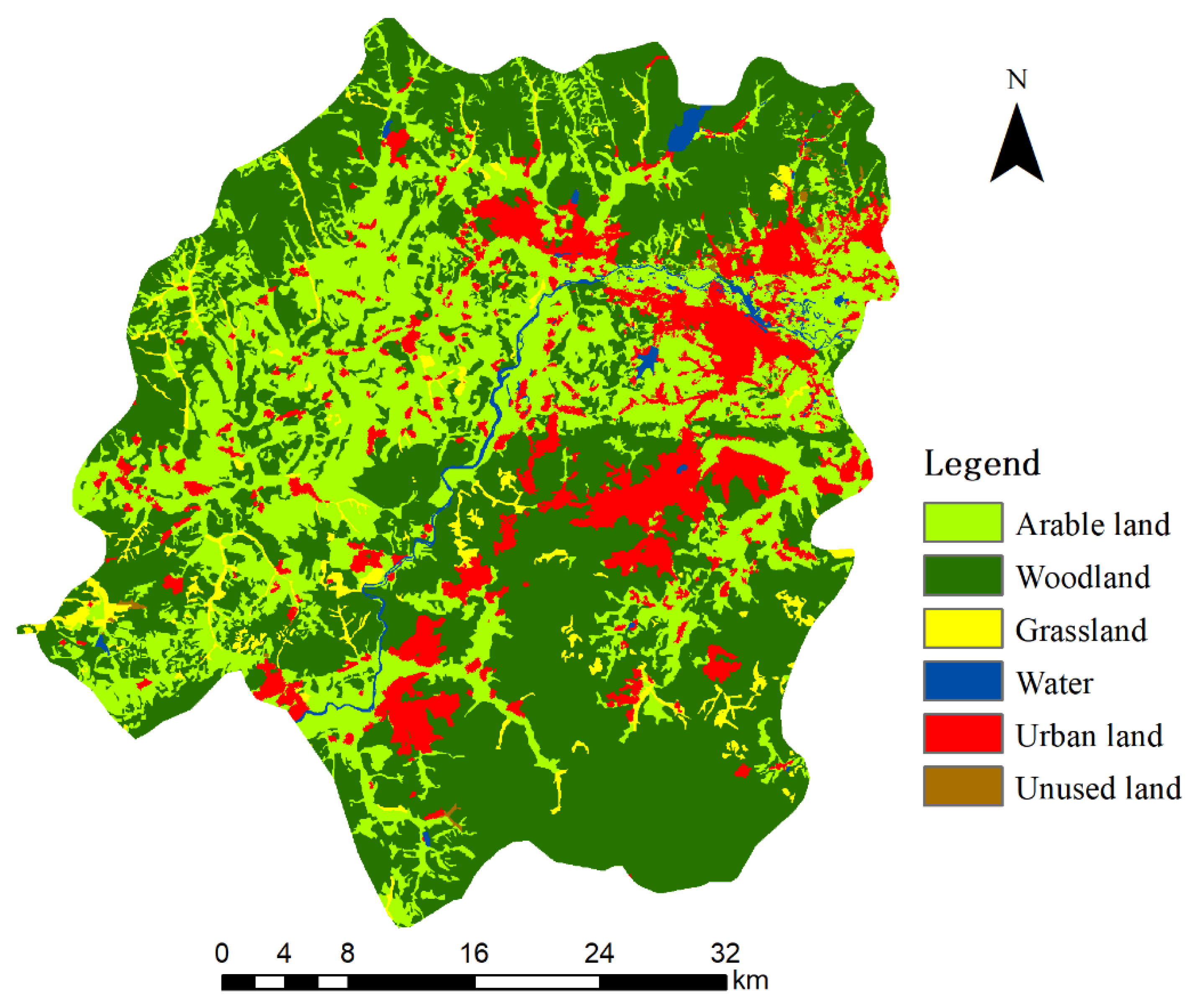
| Index | Process Mode |
|---|---|
| DEM | ASTER GDEMV2 digital elevation products, grid size of 30 m × 30 m |
| Distance to the city center (Dcenter1) | Taking Jixi Municipal Government as the center, the distance between all grid cells and the center is obtained by using “Euclidean distance” function |
| Distance to the district center of gravity (Dcenter2) | Obtain the nearest distance of all grid cells to the center of gravity of each district using “Euclidean distance” function |
| Distance to the city edge (Dedge) | Obtain the distance of all grid cells to the nearest urban land using “Euclidean distance” function |
| Distance to the mining area (Dmining) | Obtain the distance of all grid cells to the nearest mining area using “Euclidean distance” function |
| Distance to the water (Dwater) | Obtain the distance of all grid cells to the nearest water using “Euclidean distance” function |
| Distance to the railway (Drailway) | Obtain the distance of all grid cells to the nearest railway using “Euclidean distance” function |
| Distance to the highway (Droad) | Obtain the distance of all grid cells to the nearest highway using “Euclidean distance” function |
| Initial State | Arable Land | Woodland | Grass Land | Unused Land |
|---|---|---|---|---|
| urbanized | 15,096 | 14,145 | 2248 | 286 |
| Non-urbanized | 15,046 | 15,054 | 15,015 | 7007 |
| Cases | 30,142 | 29,199 | 17,263 | 7293 |
| Initial State | Arable Land | Woodland | Grass Land | Unused Land |
|---|---|---|---|---|
| Cases | 631,717 | 1,224,340 | 62,168 | 4419 |
| Index | DEM | Dcenter1 | Dcenter2 | Dedge | Dmining | Dwater | Drailway | Droad |
|---|---|---|---|---|---|---|---|---|
| Arable land | 0.0451 | 0.0458 | 0.0349 | 0.1358 | 0.0570 | 0.1211 | 0.1091 | 0.1027 |
| Woodland | 0.0193 | 0.0255 | 0.0327 | 0.1031 | 0.0661 | 0.0860 | 0.0802 | 0.0907 |
| Grass land | 0.0223 | 0.0241 | 0.0201 | 0.1023 | 0.0779 | 0.1220 | 0.0628 | 0.0679 |
| Unused land | 0.0388 | 0.0974 | 0.0461 | 0.1656 | 0.0373 | 0.0981 | 0.1199 | 0.0988 |
| Initial State | Arable Land | Woodland | Grass Land | Unused Land |
|---|---|---|---|---|
| QD | 37,382 | 10,897 | 838 | 391 |
| x = 2 | |||
|---|---|---|---|
| Simulated Non-Urban | Simulated Urban | Accuracy | |
| Actual non-urban | 2,063,873 | 35,412 | 98.31% |
| Actual urban | 35,831 | 240,334 | 87.03% |
| Total accuracy | 97.00% | ||
| x = 5 | |||
| Simulated non-urban | Simulated urban | Accuracy | |
| Actual non-urban | 2,064,141 | 35,144 | 98.33% |
| Actual urban | 35,563 | 240,602 | 87.12% |
| Total accuracy | 97.02% | ||
| x = 10 | |||
| Simulated non-urban | Simulated urban | Accuracy | |
| Actual non-urban | 2,064,154 | 35,131 | 98.33% |
| Actual urban | 35,550 | 240,615 | 87.13% |
| Total accuracy | 97.02% | ||
| x = 20 | |||
| Simulated non-urban | Simulated urban | Accuracy | |
| Actual non-urban | 2,063,808 | 35,477 | 98.31% |
| Actual urban | 35,896 | 240,269 | 87.00% |
| Total accuracy | 97.00% | ||
| x = 50 | |||
| Simulated non-urban | Simulated urban | Accuracy | |
| Actual non-urban | 2,063,767 | 35,518 | 98.31% |
| Actual urban | 35,937 | 240,228 | 87.00% |
| Total accuracy | 96.99% | ||
| x = 100 | |||
| Simulated non-urban | Simulated urban | Accuracy | |
| Actual non-urban | 2,063,789 | 35,496 | 98.31% |
| Actual urban | 35,915 | 240,250 | 87.00% |
| Total accuracy | 96.99% | ||
| Retrieval Quantity | x = 2 | x = 5 | x = 10 | x = 20 | x = 50 | x = 100 |
|---|---|---|---|---|---|---|
| Kappa | 85.39% | 85.50% | 85.51% | 85.37% | 85.35% | 85.35% |
| FoM | 0.1660 | 0.1697 | 0.1699 | 0.1651 | 0.1645 | 0.1645 |
| Retrieval Strategy | Comprehensive | Single |
|---|---|---|
| Correct | 319 | 134 |
| Incorrect | 1064 | 1249 |
| Accuracy | 23.07% | 9.69% |
| Simulated Urban | Simulated Non-Urban | Accuracy | |
|---|---|---|---|
| Actual urban | 240,124 | 36,041 | 86.99% |
| Actual non-urban | 35,622 | 2,063,663 | 98.31% |
| Total accuracy | 96.99% |
| Accuracy | Kappa | FoM | |
|---|---|---|---|
| CBR (x = 10) | 97.02% | 85.51% | 0.170 |
| CA | 96.91% | 84.98% | 0.148 |
Publisher’s Note: MDPI stays neutral with regard to jurisdictional claims in published maps and institutional affiliations. |
© 2021 by the authors. Licensee MDPI, Basel, Switzerland. This article is an open access article distributed under the terms and conditions of the Creative Commons Attribution (CC BY) license (https://creativecommons.org/licenses/by/4.0/).
Share and Cite
Ye, X.; Yu, W.; Lv, L.; Zang, S.; Ni, H. An Improved Case-Based Reasoning Model for Simulating Urban Growth. Sustainability 2021, 13, 6146. https://doi.org/10.3390/su13116146
Ye X, Yu W, Lv L, Zang S, Ni H. An Improved Case-Based Reasoning Model for Simulating Urban Growth. Sustainability. 2021; 13(11):6146. https://doi.org/10.3390/su13116146
Chicago/Turabian StyleYe, Xin, Wenhui Yu, Lina Lv, Shuying Zang, and Hongwei Ni. 2021. "An Improved Case-Based Reasoning Model for Simulating Urban Growth" Sustainability 13, no. 11: 6146. https://doi.org/10.3390/su13116146
APA StyleYe, X., Yu, W., Lv, L., Zang, S., & Ni, H. (2021). An Improved Case-Based Reasoning Model for Simulating Urban Growth. Sustainability, 13(11), 6146. https://doi.org/10.3390/su13116146





